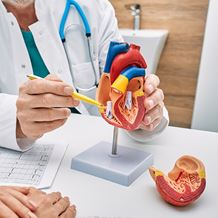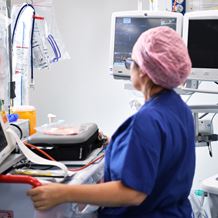
- Home
- Services
- Cardiac Services
- Procedures and Treatments
- Ventricular Septal Defect Closures
What is are septal defect closures?
Ventricular septal defect closure is a medical procedure to repair an abnormal opening in the wall of the lower heart chambers. This is known as a ventricular septal defect (VSD) and it is a very common heart condition that often occurs alongside other heart problems. VSDs are usually diagnosed at birth but some may not be diagnosed until adulthood. Treatment will depend on the size and location of the hole. If the hole is big enough to cause further health complications, or damage to other parts of the heart such as the valves, ventricular defect surgery may be recommended to close up the opening in the heart wall.
What does it do?
Ventricular septal defect closure is a surgical treatment to repair a structural heart problem and help protect your health for the future. In a healthy heart, the lower chambers are separated by the heart wall, and they have separate responsibilities in pumping blood around your body. When a VSD occurs, it changes how blood flows through the heart, and increases pressure on the lungs. Ventricular septal defect closure surgically seals the hole and separates the chambers so that they can resume their individual function and operate effectively.
How does it work?
Once the VSD has been diagnosed using various tests such as an echocardiogram, chest X-ray, ECG (electrocardiogram), and CT scanning, your doctor may recommend surgical closure. Ventricular septal defect closure works by restoring the heart wall using a special patch or device. A mesh patch or closure device is passed through to the heart using a catheter, or applied through open heart surgery. Heart tissue then naturally grows around the hole which permanently seals it closed as it forms a natural part of the heart wall.
Why is it performed?
Most Ventricular septal defects are present from birth, although a diagnosis can happen in adulthood. They can range in size with only the larger VSDs typically requiring surgical repair. If the defect is large or causing severe symptoms, your doctor may recommend ventricular septal defect closure as the best treatment pathway for the future. If it is not treated in time, Eisenmenger Syndrome may develop as a result of long-term damage to the lungs. VSD symptoms generally include:
Non-invasive (percutaneous):
- A local anaesthetic is applied to the groin area
- A special catheter is inserted into the leg vein, carrying the closure device
- The catheter is guided up towards the location of the hole
- Once in position the device is released and the hole is plugged
Surgical approach:
- A general anaesthetic is given
- You are attached to a heart-lung bypass machine which controls your heartbeat
- An incision is made in your chest
- The hole is repaired using a special patch or stitches
- The wound is closed and dressed
Procedure
There are several techniques for VSD closure. It is usually performed using minimally invasive techniques or as open-heart surgery. Your doctor will talk to you about the most appropriate procedure for your condition.
Recovery
After the operation, your progress is closely monitored and your doctor will take some images of your heart to ensure the VSD has sealed successfully. Your medical team will talk to you about what to expect during your recovery, and any medication required. Follow-up appointments are typically necessary to ensure the success of the surgical procedure.
What's next?
If you have been experiencing heart-related symptoms, book an appointment with our cardiac services specialist today.
Our specialists in Cardiac Services
View all specialists





